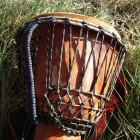4 or 6? An exercise in African polyrhythm
Part 1: Sangban to the rescue
In the African electric band I played with (Kikeyambay), we performed a song called “Aydarasifo.” The interesting thing about this song is that some of the parts are in 4/4 time and some in 6/8 (actually 12/8) time.
The guitar and vocal parts have a 4/4 feel, with notes spaced as follows:
The dunun set (upright, ballet-style) and djembe parts are in 12/8:
(g, d = tone; P, T = slap) (D=dununba, S=sangban, K=kenkeni)
To juxtapose these parts with different timings is a challenge! – some might even say, a logical impossibility. To the rescue comes the sangban/bell part, which can be felt and played with either timing:
(x=bell only, O=open hit, with bell)
In practice the sangban feel can move subtly between the two timings, playing with more or less duration given to the rests between the notes. This elastic feel gives extra depth and dynamic to the sangban part and to the music as a whole – but is not for the faint of heart!
To the African sensibility our notation-mapping exercise is just that – an exercise for Western logic. This example illustrates the drummer’s truism, “The map is not the territory.” Still, it helps to know where we are going, and the options available for how to get there.
Part 2: Ballet duns, changing on the fly
For a recent street show in Kihei, Maui, I was asked to play standup duns, a set of three. We didn’t rehease much but had jammed together a lot and performed before, so the comfort level was established. The lead drummer said we’d play Soli, a 6/8 piece, and we ran through it vocally to brush up, with the standard 6/8 break.
With the signal to start, however, the djembe played the universal break in 4/4, and before I could adjust away from Soli, I heard a couple of bars of the 4/4 standard accompaniment part known as “passport”:
which confirmed that we were now playing in 4. I had already begun the Soli phrase in 6 on the ballet style duns (D=dununba, S=sangban, K=kenkeni):
Without thinking (there was no time for that) I found myself morphing the rhythm on the duns to fit the djembe timing in 4 … and within another bar or two, I realized I was now on familiar ground with Kassa, a traditional rhythm played in 4 (with a variation):
From this experience came the flash of insight that Soli and Kassa were closely related rhythms: one in 6, the other in 4.
Once this correspondence is realized, I’m sure that many other rhythms in the West African tradition can be paired in this way. As to whether such rhythm pairs evolved from a common source, I’ll leave that to the ethnomusicologists. The point is, there is freedom in the ability to move freely between the binary and ternary worlds, for in reality it is a limited distinction.
For lots more on polyrhythms, be sure to check out…
 Roots Jam 4: World Beats – Rhythms Wild!
Roots Jam 4: World Beats – Rhythms Wild!
with chapters and charts, lessons and exercises on…
- Polyrhythms Simplified
- Polyrhythms Wild
- Unirhythm
- Claves Wild
- Son/Rumba: Long/Short
- Stretchin’ the Swing: Timing Exercises
- Samba Snare, “Ginga” Style
